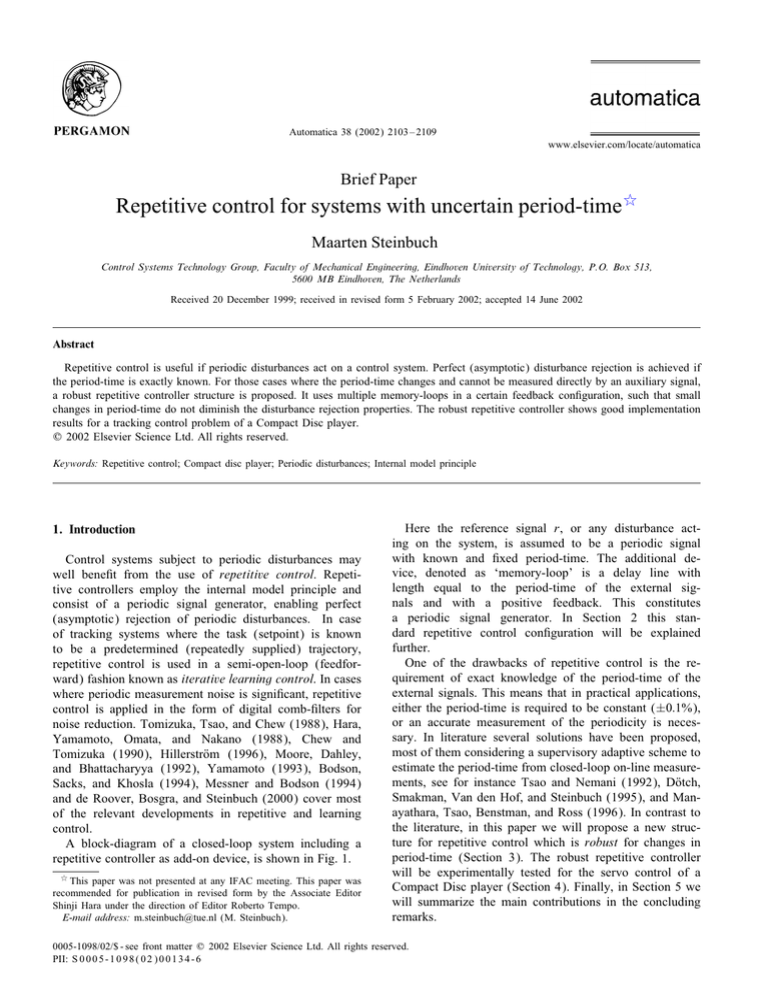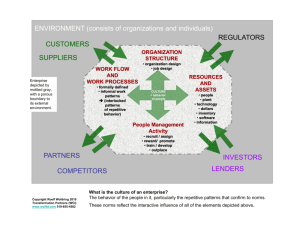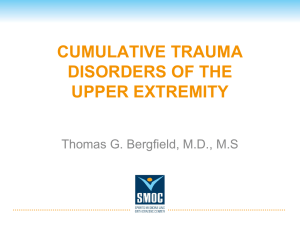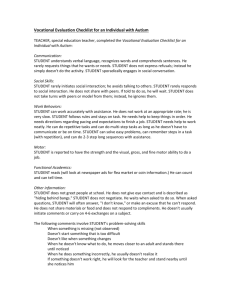
Automatica 38 (2002) 2103 – 2109
www.elsevier.com/locate/automatica
Brief Paper
Repetitive control for systems with uncertain period-time Maarten Steinbuch
Control Systems Technology Group, Faculty of Mechanical Engineering, Eindhoven University of Technology, P.O. Box 513,
5600 MB Eindhoven, The Netherlands
Received 20 December 1999; received in revised form 5 February 2002; accepted 14 June 2002
Abstract
Repetitive control is useful if periodic disturbances act on a control system. Perfect (asymptotic) disturbance rejection is achieved if
the period-time is exactly known. For those cases where the period-time changes and cannot be measured directly by an auxiliary signal,
a robust repetitive controller structure is proposed. It uses multiple memory-loops in a certain feedback con3guration, such that small
changes in period-time do not diminish the disturbance rejection properties. The robust repetitive controller shows good implementation
results for a tracking control problem of a Compact Disc player.
? 2002 Elsevier Science Ltd. All rights reserved.
Keywords: Repetitive control; Compact disc player; Periodic disturbances; Internal model principle
1. Introduction
Control systems subject to periodic disturbances may
well bene3t from the use of repetitive control. Repetitive controllers employ the internal model principle and
consist of a periodic signal generator, enabling perfect
(asymptotic) rejection of periodic disturbances. In case
of tracking systems where the task (setpoint) is known
to be a predetermined (repeatedly supplied) trajectory,
repetitive control is used in a semi-open-loop (feedforward) fashion known as iterative learning control. In cases
where periodic measurement noise is signi3cant, repetitive
control is applied in the form of digital comb-3lters for
noise reduction. Tomizuka, Tsao, and Chew (1988), Hara,
Yamamoto, Omata, and Nakano (1988), Chew and
Tomizuka (1990), Hillerstr=om (1996), Moore, Dahley,
and Bhattacharyya (1992), Yamamoto (1993), Bodson,
Sacks, and Khosla (1994), Messner and Bodson (1994)
and de Roover, Bosgra, and Steinbuch (2000) cover most
of the relevant developments in repetitive and learning
control.
A block-diagram of a closed-loop system including a
repetitive controller as add-on device, is shown in Fig. 1.
This paper was not presented at any IFAC meeting. This paper was
recommended for publication in revised form by the Associate Editor
Shinji Hara under the direction of Editor Roberto Tempo.
E-mail address: m.steinbuch@tue.nl (M. Steinbuch).
Here the reference signal r, or any disturbance acting on the system, is assumed to be a periodic signal
with known and 3xed period-time. The additional device, denoted as ‘memory-loop’ is a delay line with
length equal to the period-time of the external signals and with a positive feedback. This constitutes
a periodic signal generator. In Section 2 this standard repetitive control con3guration will be explained
further.
One of the drawbacks of repetitive control is the requirement of exact knowledge of the period-time of the
external signals. This means that in practical applications,
either the period-time is required to be constant (±0:1%),
or an accurate measurement of the periodicity is necessary. In literature several solutions have been proposed,
most of them considering a supervisory adaptive scheme to
estimate the period-time from closed-loop on-line measurements, see for instance Tsao and Nemani (1992), D=otch,
Smakman, Van den Hof, and Steinbuch (1995), and Manayathara, Tsao, Benstman, and Ross (1996). In contrast to
the literature, in this paper we will propose a new structure for repetitive control which is robust for changes in
period-time (Section 3). The robust repetitive controller
will be experimentally tested for the servo control of a
Compact Disc player (Section 4). Finally, in Section 5 we
will summarize the main contributions in the concluding
remarks.
0005-1098/02/$ - see front matter ? 2002 Elsevier Science Ltd. All rights reserved.
PII: S 0 0 0 5 - 1 0 9 8 ( 0 2 ) 0 0 1 3 4 - 6
2104
M. Steinbuch / Automatica 38 (2002) 2103–2109
controller
r
+
+ e′
+
z
e
-
C
plant
e
P
z
e-sTp
+
Fig. 2. Block diagram of a standard memory-loop.
2. Repetitive control
2.1. Periodic signal generator
The internal model principle (Francis & Wonham, 1975)
states that for asymptotically tracking a reference command
by the output of a closed-loop system, a realization (model)
of the disturbance=reference generating system should be
included in the feedback loop. As a well-known example,
signals with a DC (! = 0) content can be modelled using an integrator, and inclusion of integral action in the
feedback controller prevents steady-state errors for constant
references and disturbances. A discrete time integrator is a
positive feedback over one delay, implying that one memory location is used to store the integral value. With zero
input the integral value updates itself by the positive feedback loop.
Similarly, for periodic signals, a memory loop can be used
which generates an output at frequencies k!p , with k integer
and !p the period frequency. In a memory loop, a signal with
period Tp = 2=!p is stored in a FIFO buLer. Depending on
Tp and the sample frequency a number of memory locations
is needed. If a positive feedback is put over this FIFO buLer,
in steady state no input is needed to generate an output
with period time Tp . Such a periodic signal has a discrete
frequency spectrum with peaks at !=k!p . A block diagram
of a memory-loop with period time Tp is shown in Fig. 2.
Although the common implementation of memory-loops
is done in discrete time, in this paper we will adopt a description in continuous time in order to derive some insightful
results. Note that a time delay is equal to e−sTp . The transfer
function from e to z is (see Fig. 2)
z
e−sTp
:
= G(s) =
e
1 − e−sTp
e-sTp
L (s)
z
Fig. 3. Block diagram of the implemented memory-loop.
Fig. 1. Block diagram of a control loop including a repetitive controller.
+
Q (s)
+
memory
loop
e
+
y
(1)
For frequencies ! = k!p = k2=Tp the magnitude of the
denominator of G(s) is zero, making the gain of the transfer function in3nite. This, of course, is the intended working principle of the repetitive controller: to have in3nite
loop gain at the harmonics of the disturbance. However,
such gains may easily cause stability problems in the main
(outer) servo loop. Stability of repetitive controllers has been
thoroughly analyzed by Tomizuka et al. (1988), Chew and
Tomizuka (1990) and Hillerstr=om (1996). To guarantee stability two 3lters Q(s) and L(s) are added to the repetitive
signal generator as shown in Fig. 3.
The 3lter L(s) usually is called the learning 3lter, and it
is used to compensate the transfer as seen by the repetitive
controller. The 3lter Q(s) is used to reMect the mismatch
between L(s) and the real system; it limits the working of
the repetitive controller to a certain frequency band. It is
bene3cial to construct Q(s) such that its phase behavior is
linear with frequency. In that case we can compensate the
phase delay introduced by Q(s) by adjusting the delay of
the periodic signal generator. It is not the purpose of this
paper to investigate the design of the 3lters L(s) and Q(s).
Instead we refer to the literature (Tomizuka et al., 1988;
Hillerstr=om, 1996).
2.2. Sensitivity analysis
Let us return to the basic building block of a repetitive
controller, see Fig. 2. A frequency response of this 3lter
G(s) is shown in Fig. 4 for the 3rst few harmonics (13 in
this case; Tp = 1=7:5 s). Clearly, at the harmonic frequencies
the gain is in3nite as predicted from Eq. (1).
However, the additional gain is only obtained in a very
limited frequency band centered around each harmonic. In
some applications the period time is not exactly known or
cannot be measured accurately enough. To further analyze
the sensitivity of the repetitive controller for changes in the
period-time, consider Eq. (1) if the period time is perturbed
with a multiplicative error : Tp (1 + ).
The transfer function Gp (s) for the perturbed periodic
signal generator then becomes
z
e−sTp (1+)
= Gp (s) =
e
1 − e−sTp (1+)
and at the harmonics we obtain with s = jk2=Tp :
(2)
e−j k2(1+)
z
=
:
(3)
e 1 − e−j k2(1+)
In Fig. 5 the magnitude of Eq. (3), for the 3rst harmonic
(k = 1), is plotted as a function of the perturbation : solid
M. Steinbuch / Automatica 38 (2002) 2103–2109
2105
103
magnitude
102
101
100
10−1
100
101
102
frequency [Hz]
Fig. 4. Magnitude frequency response G(j!) of a periodic signal generator.
103
N=3
N=2
magnitude
102
N=1
101
100
0
0.5
1
1.5
2
2.5
3
3.5
4
change of periodicity α [%]
Fig. 5. Magnitude of a periodic signal generator as function of the period-mismatch, evaluated for the 3rst harmonic (k = 1), for the standard repetitive
controller (N = 1), and for robust repetitive controllers (N = 2 and N = 3).
line (with label N = 1; the variable N will be introduced in
the next section). As can be seen, already for a perturbation
of 1.5% ( = 0:015) the gain drops from ∞ to 10. For
higher harmonics (not shown in the 3gure) this is even more
pronounced: for example for the tenth harmonic (k = 10),
the gain is only 1.1.
2106
e
M. Steinbuch / Automatica 38 (2002) 2103–2109
+
e-sTp
e-sTp
hence, for the case with N ¿ 1,
e-sTp
+
N
W3
W2
W1
+
+ z
Fig. 6. Generalized repetitive controller.
In the next section we will present an extended repetitive
controller to improve the robustness for uncertainties in the
period-time.
3. Robust repetitive control
Consider a generalized repetitive controller, consisting of
multiple periodic signal generators in a structure as shown
in Fig. 6 for an example with three elements.
In Gotou, Ueta, Nakamura, and Matsuo (1991) also multiple memory loops are used, but here the weighting factors
are used to modify the dynamic response in between the
harmonic frequencies.
The transfer function of a generalized repetitive controller
with N periodic signal generators can be written as
(4)
with the loop transfer function H (s):
H (s) =
N
Wi e−isTp :
(5)
i=1
Again, we would like the periodic signal generator G(s)
to become in3nite at the harmonics, i.e. H (s) = 1 for s =
jk2=Tp . Substitution of these values of s into Eq. (5) gives
H (jk2=Tp ) =
N
Wi e−ij k2 =
i=1
N
Wi = 1:
(6)
@H (s = jk2=Tp )
=0
@Tp
@H (s) @
=
@Tp
N
(7)
N
Wi e−isTp =
− Wi ise−isTp
@Tp
i=1
(8)
i=1
and for s = jk2=Tp we 3nd
N
@H (jk2=Tp ) =
− Wi ijk2=Tp = 0
@Tp
i=1
N
Wi i(N −1) = 0:
(11)
i=1
In Fig. 7 the magnitude frequency responses are plotted
for a repetitive controller with one, two and three memory loops, respectively. Clearly, for a wider frequency band
around the harmonics the gain is higher, which leads to a
smaller sensitivity for period-time changes. This can also be
observed in the sensitivity plot Fig. 5 (N = 2; 3).
As an example consider the case with two memory loops
(N = 2). Then we 3nd from Eqs. (6) and (10) W1 + W2 = 1
and W1 + 2W2 = 0, hence W1 = 2, W2 = −1 is the solution
pair. By induction we can state that the proposed robust
repetitive controller with N weights is given by
z
1 − (1 − e−sTp )N
:
=
e
(1 − e−sTp )N
(12)
It should be noted that an equivalent principle occurs in
the time domain for robustifying the so-called input shapers,
see Singer (1993) and Singh and Vadali (1993). The robust repetitive controller proposed here has been successfully patented (Steinbuch & Schootstra, 1998); an adaptive
version has been developed for handling larger variations
of the period-time. This adaptive version is based on correlation analysis of stored information in the FIFO buLer,
see Schootstra and Steinbuch (1998). In the next section we
will show experimental results for the tracking problem of
a Compact Disc mechanism.
i=1
Indeed for N =1, we 3nd W1 =1 which gives the standard
repetitive controller from the previous section. In order to
improve the robustness of the repetitive controller for variations of the period-time, we also impose the requirement
which gives
(10)
will meet the requirement.
Since we have a structure with N delay lines, and N
parameters Wi , we can impose N constraints. To further
decrease the sensitivity for period-time variations, we can
impose upto (N − 1)th derivatives equal to zero:
+
z
H (s)
= G(s) =
e
1 − H (s)
Wi i = 0
i=1
(9)
4. Application to a compact disc drive
4.1. Standard repetitive control
In Fig. 8 a schematic view of a Compact Disc mechanism is shown. The mechanism is composed of a turn-table
DC-motor for the rotation of the Compact Disc, and a radial
arm for the track-following. An objective lens, suspended
by two parallel leaf springs, can move in a vertical direction
to give a focusing action.
In Fig. 9 a block-diagram of the radial (tracking) control loop is shown. The diLerence between the radial track
position and the spot position is detected by the optical
pick-up; it generates a radial error signal (RE) (Steinbuch,
van Groos, Schootstra, Wortelboer, & Bosgra, 1998). In
current systems the servo controller is a PID controller
M. Steinbuch / Automatica 38 (2002) 2103–2109
2107
103
magnitude
102
101
N
3
2
100
z
10−1
100
101
frequency [Hz]
102
Fig. 7. Magnitude frequency responses G(j!) of multiple periodic signal generators.
magnitude
108
105
102
10−1
100
101
102
103
phase
frequency [hz]
Fig. 8. Schematic view of a rotating arm Compact Disc mechanism.
track
RE
current
servo
actuator
position
300
250
200
150
100
50
100
101
102
frequency [Hz]
103
Fig. 10. Open-loop frequency response of a memory-loop in series with
a PID controller and a double integrator.
-
Fig. 9. Con3guration of the Compact Disc tracking control loop.
(Steinbuch & Norg, 1998). The tracking control loop has a
cross-over frequency of 500 Hz.
Fig. 10 shows the open-loop frequency response of the
Compact Disc control system model, in this case a series
connection of a double integrator as plant (mass to be
positioned), a lead 3lter with integral action (PID controller
(Steinbuch & Norg, 1998)) and the repetitive controller
(with low-pass digital FIR 3lters Q(z) and L(z), cut-oL at
150 Hz, with linear phase characteristics). Using frequency
response analysis, stability of the controlled system can be
checked, using standard Nyquist arguments. Note that the
phase change at the harmonic frequencies is from 270 back
◦
to 90 and thus compensates for the phase change between
the harmonics.
M. Steinbuch / Automatica 38 (2002) 2103–2109
10−1
10−1
10−2
10−2
amplitude
amplitude
2108
10−3
10−4
10−5
0
50
150
100
200
250
10−3
10−4
10−5
300
z
Fig. 11. Amplitude spectrum of radial error (RE) using a standard servo
loop.
0
50
100
150
200
frequency [Hz]
250
300
Fig. 14. Spectrum of RE using a robust (N = 2) memory-loop perturbed
by 0.5%.
0.2
error
amplitude
10−1
10−2
10−3
0
-0.2
10−4
10−5
0
50
100
150
200
250
0
0.05
0.1
0.15
0.2 0.25
time [s]
0.3
0.35
0.4
0
0.05
0.1
0.15
0.2 0.25
time [s]
0.3
0.35
0.4
300
0.2
Fig. 12. Amplitude spectrum of RE when a memory-loop is added.
error
frequency [Hz]
0
-0.2
amplitude
10−1
10−2
Fig. 15. Remaining error signals of a standard (top) and a robust
memory-loop (bottom) when the period-time is perturbed by 0.5%.
10−3
10−4
10−5
0
50
100
150
200
frequency [Hz]
250
300
Fig. 13. Spectrum of RE using a standard memory-loop perturbed by
0.5%.
A measured amplitude spectrum of the radial servo error
(RE) is shown in Fig. 11 for the PID controlled tracking
servo. The periodic contents of the tracking error is clearly
visible in a large number of harmonics of the rotational
frequency (!p = 27:5 rad=s) of the disc.
If a memory-loop is correctly tuned and locked to the
disturbance period, error reductions can be very large. As
an example the amplitude spectrum of the resulting radial
tracking error is shown in Fig. 12. Up to a frequency of
150 Hz (20 harmonics) the periodic components are suppressed. This clearly shows the remarkable improvements
possible with repetitive control. However, as mentioned before, the improvements are very sensitive for variations of
the period-time. To show this, we changed the frequency of
the disc by only 0.5%, while keeping the same repetitive
controller. The resulting amplitude spectrum of the radial
tracking error is shown in Fig. 13.
4.2. Implementation results with robust repetitive control
In order to evaluate the robust memory-loop in reality,
an implementation has been done for the case N = 2. The
amplitude spectrum of the tracking error is shown in Fig.
14 for the robust (N = 2) repetitive controller with a 0.5%
change in disc rotational frequency. Compare this with the
spectrum plot in Fig. 13 for the standard (N = 1) repetitive
controller. It is clear that the robust memory-loop has a
much better reduction compared to the N = 1 case. The
improvement can be predicted also for other perturbation
levels, by the use of Fig. 5.
Finally, the error signals in the time-domain are shown
in Fig. 15 (the time-domain signals are low-pass 3ltered at
125 Hz in order to show the diLerence more clearly).
The robusti3cation of the memory-loop as explained
above, of course, has the disadvantage of the need of more
storage capacity. This increases with the length NTp of the
FIFO.
5. Conclusions
The use of memory-loops is bene3cial in systems with
repetitive disturbances or tasks. In order to improve the ca-
M. Steinbuch / Automatica 38 (2002) 2103–2109
pabilities of repetitive controllers for those cases where the
periodicity is hard to measure and is subject to variation, an
extension of repetitive control is developed. By using multiple memory-loops, and correct design of the coeQcients,
signi3cant robustness is achieved for small variations in the
period time. The robust repetitive controller has been implemented successfully in a digital control setup of a Compact Disc player. Future research will be focused on possible
application of the same idea to the so-called ‘high-order’
iterative learning control.
Acknowledgements
The author would like to thank Gerrit Schootstra for his
participation in the project, and Tarunraj Singh, University
of BuLalo, for helpful suggestions and corrections, especially for pointing out Eq. (12).
References
Bodson, M., Sacks, A., & Khosla, P. (1994). Harmonic generation in
adaptive feedforward cancellation schemes, IEEE Transactions on
Automatic Control, 39(9), 1939 –1944.
Chew, K. K., & Tomizuka, M. (1990). Digital control of repetitive errors
in disk drive systems. Proceedings of the American control conference
(pp. 540 –548).
D=otch, H. G. M., Smakman, H. T., Van den Hof, P. M. J., & Steinbuch,
M. (1995). Adaptive repetitive control of a compact disc mechanism.
Proceedings of the 1995 IEEE conference on decision and control,
New Orleans (pp. 1720 –1725).
Francis, B. A., & Wonham, W. M. (1975). The internal model principle
for linear multivariable regulators. Applied Mathematics and Optics,
2, 170–194.
Gotou, M., Ueta, E., Nakamura, A., & Matsuo, K. (1991). Development of
multirate sampling repetitive learning servo system and its application
to a compact camcorder. IEEE=RSJ international workshop on
intelligent robots and systems IROS ’91 (pp. 647– 654).
Hara, S., Yamamoto, Y., Omata, T., & Nakano, M. (1988). Repetitive
control system—a new-type servo system. IEEE Transactions on
Automatic Control, AC-33, 659–668.
Hillerstr=om, G. (1996). Adaptive suppression of vibrations–a repetitive
control approach. IEEE Transactions on Control Systems
Technology, 4(1), 72–77.
Manayathara, Th. J., Tsao, T. -C., Bentsman, J., & Ross, D. (1996).
Rejection of unknown periodic load disturbances in continuous steel
casting process using learning repetitive control approach. IEEE
Transactions on Control Systems Technology, 4(3), 259–265.
Messner, W., & Bodson, M. (1994). Design of adaptive feedforward
controllers using internal model equivalence. Proceedings of the
American control conference (pp. 1619 –1623).
2109
Moore, K. L., Dahley, M., & Bhattacharyya, S. P. (1992). Iterative
learning control: A survey and new results. Journal of Robotic
Systems, 9(5), 563–594.
de Roover, D., Bosgra, O. H., & Steinbuch, M. (2000). Internal model
based design of repetitive and iterative learning controllers for linear
multivariable systems. International Journal of Control, 73(10),
914–929.
Schootstra, G., & Steinbuch, M. (1998). Control system for a process
that exhibits periodic disturbances. US Patent No. 5,7842,272,
July, 21.
Singer, N. C. (1993). Residual vibration reduction in computer controlled
machines. Ph. D. thesis, Massachussets Institute of Technology.
Singh, T., & Vadali, S. R. (1993). Robust time delay Control. ASME
Journal of Dynamic Systems, Measurement and Control, 115(2A),
303–306.
Steinbuch, M., & Norg, M. L. (1998). Advanced motion control: An
industrial perspective. European Journal of Control, 278–293.
Steinbuch, M., & Schootstra, G. (1998). Filter, repetitive control system
and learning control system both provided with such =lter. US Patent
No. 5,740,090, April 14.
Steinbuch, M., van Groos, P. J. M., Schootstra, G., Wortelboer, P.
M., & Bosgra, O. H. (1998). -Synthesis of a compact disc player.
International Journal of Robust and Nonlinear Control, 8, 169–189.
Tomizuka, M., Tsao, T. C., & Chew, K. K. (1988). Discrete-time domain
analysis and synthesis of repetitive controllers. Proceedings of the
1988 American control conference (pp. 860 –866).
Tsao, T. C., & Nemani, M. (1992). Asymptotic rejection of periodic
disturbances with uncertain period. Proceedings of the American
control conference (pp. 2696 –2699).
Yamamoto, Y. (1993). Learning control and related problems in
in3nite-dimensional systems. in: H. L. Trentelman & J. C. Willems
(Eds.), Essays on control: Perspectives in the theory and its
applications (pp. 191–222). Boston: Birkhauser.
Maarten Steinbuch received M.Sc. (cum
laude) in Mechanical Engineering from
Delft University of Technology, Delft, The
Netherlands, in 1984. From 1984 until 1987
he was a research assistant at Delft University of Technology and KEMA (Power
Industry Research Institute), Arnhem, The
Netherlands. In 1989 he received Ph.D.
(Dr.) from Delft University of Technology
on the subject of Modelling and Control of
Wind Energy Conversion Systems. From
1987 to 1998 he was with Philips Research
Labs., Eindhoven as a member of the Scienti3c StaL, working on modelling and control of mechatronic applications. From 1998 to 1999 he
was a manager of the Dynamics and Control group at Philips Center for
Manufacturing Technology. Since 1999 he is a full professor of the Control Systems Technology group of the Mechanical Engineering Department of Eindhoven University of Technology.Prof. Steinbuch has over 70
refereed journal and conference publications, and holds two patents. His
research interests are modelling and control of motion systems.He was
an associate editor of the IEEE Transactions on Control Systems Technology (1993–1997) and of IFAC Control Engineering Practice (1994
–1996). He is currently associate editor of the IEEE Control Systems
Magazine and editor-at-large of the European Journal of Control.







